Things You'll Need
Whole milk Greek yogurt made from cow's milk or goat's milk
Measuring cups
Measuring spoons
2 tsp. white flour, optional
2 tsp. cornstarch, optional
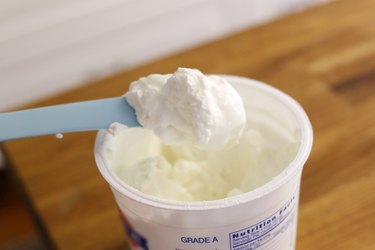
Greek yogurt is similar to regular yogurt, but drained of water. Make it at home by draining plain yogurt through cheesecloth for a day or two, or purchase at grocery stores, Middle Eastern markets or specialty gourmet stores. You can purchase Greek yogurt plain or flavored with honey or fruit. Most Greek yogurt in the U.S. comes from cow's milk, though you can find goat's milk Greek yogurt at some gourmet shops. Served plain, whole milk Greek yogurt tastes similar to sour cream. When used in baking and cooking, it can taste just like sour cream.
Baking
Step 1
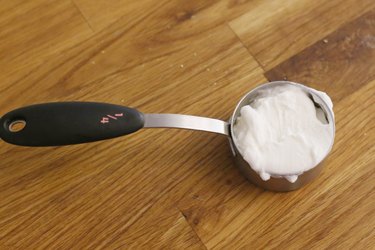
Measure the amount of Greek yogurt that the recipe calls for in sour cream.
Video of the Day
Step 2

Replace the sour cream with plain Greek yogurt. Cow's milk Greek yogurt is more affordable than goat's milk yogurt, and you may substitute with identical results in baking. It is unlikely to curdle in baking.
Step 3
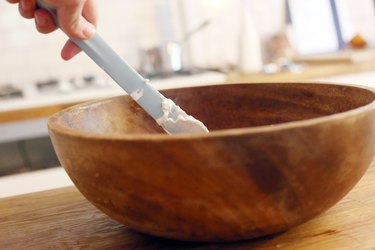
Mix into the batter or dough as specified in the recipe, and proceed.
Marinades, Dressings and Stovetop Sauces
Step 1
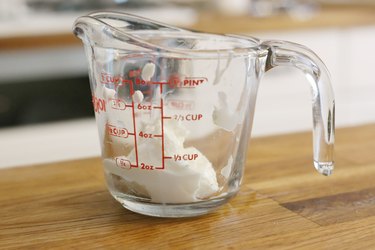
Measure the amount of Greek yogurt that the recipe calls for in sour cream.
Step 2
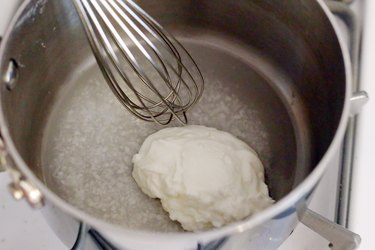
Add 2 tsp. white flour or cornstarch to cow's milk Greek yogurt over low heat. Whisk vigorously until fully combined; this prevents curdling later when cooked on high heat or mixed with acidic ingredients. You may bypass this step altogether by using goat's milk yogurt, which never curdles when heated.
Step 3
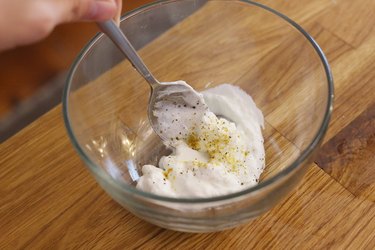
Add goat's milk Greek yogurt to your sauce, dressing or marinade as specified in the recipe, and replicate exactly; it will not curdle. Cow's milk yogurt with added flour or cornstarch is unlikely to curdle, but warrants more caution. If using cow's milk yogurt, cook at 25 degrees Fahrenheit lower than specified in the recipe.
Tip
Though Greek yogurt and sour cream do not taste exactly alike on their own, you can use greek yogurt as a garnish in its place for a passable substitute. This works well with Mexican and Tex-Mex dishes.
Whole milk Greek yogurt is lower in fat than sour cream even though it contains more fat than other varieties of yogurt. As a sour cream substitute, it constitutes a healthy choice.
Greek yogurt preserves the denser part of regular yogurt, so it contains twice as much protein as regular yogurt and is lower in calories. It does contain more fat, but fills you more quickly because of the protein.
Greek yogurt is a great source of probiotics such as acidolphilus, which can help ease digestive problems and fend off yeast infections. If you have lactose intolerance, you may digest Greek yogurt more easily than other dairy products.
Plain Greek yogurt is far more versatile than sour cream. In addition to using it as a substitute for sour cream, you can use it in the morning mixed with fruit or cereal. You can use it to prepare many Greek and Indian dishes. You can use it to replace other kinds of fat in salad dressings. Experiment to figure out which ways you like using it best.
Middle Eastern markets carry a variation of Greek yogurt often produced in Lebanon that costs less than imported Greek yogurt. This yogurt substitutes well for Greek yogurt, but is not exact in flavor since it contains different cultures. Lebanese yogurt has a sharper flavor than Greek yogurt, so taste as you prepare your food rather than substituting exact proportions.
The flavor of goat's milk yogurt differs slightly from that of cow's milk yogurt; you will notice a slight difference in some cooked sauces, but not when you use it in baking.
Warning
Avoid using low fat or fat-free Greek yogurts to replace sour cream. They do not replicate its flavor nearly as well as whole milk Greek yogurt.
Some producers thicken yogurts with heavy cream, sometimes packaging it as "Australian yogurt." Do not confuse this with Greek yogurt, as it lacks the sharp flavor needed to replace sour cream.
Video of the Day
- "Mother Jones": Is Goat's Milk Better than Regular?; Kiera Butler; June 2010.
- "U.S. News and World Report": Greek Yogurt vs. Regular Yogurt; Katherine Hobson; April 2009.
- Joyofbaking.com: Ingredient Substitutions.
- Gourmetsleuth.com: Sour Cream.
- "Cooking Light": Plain Yogurt and Greek Yogurt.
- ABC News Channel 15/Everything Arizona: Love Yogurt? Get Even Healthier with Greek Yogurt.
- "The New York Times Magazine": Greek Revival; Jill Santopietro; April 2008.
- The Food Network: Greek Yogurt.
- Gourmetsleuth.com: Greek Yogurt (Yiaourti).
- Indiacurry.com: How to Prevent Yogurt from Curdling when Making Curries?
- "The Daily Mail": Does Yoghurt Curdle when Heated?
- Cook's Thesaurus: Cultured Milks.